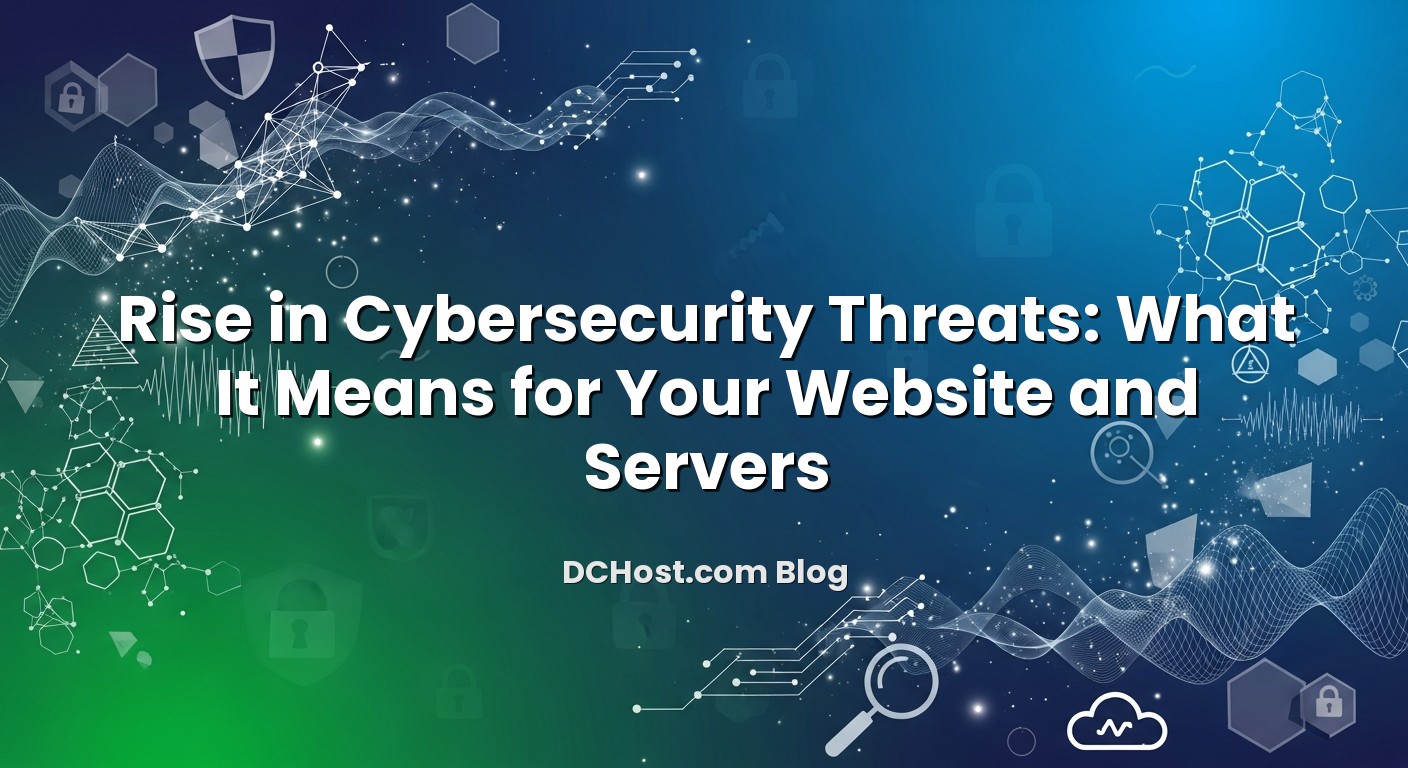Cybersecurity threats are not just a problem for banks, giant tech companies or government agencies anymore. As a hosting provider, we see automated attacks hitting small business websites, personal blogs and side projects every single day. The tools that used to be in the hands of a few advanced attackers are now packaged, automated and rented out cheaply. At the same time, you are running more services online than ever: websites, APIs, admin panels, mail servers, payment gateways and remote access tools. Every one of them expands your attack surface.
In this article, we will break down why cybersecurity threats are rising, what kinds of attacks we most often see against hosting environments, and what this realistically means for your domains, hosting plans, VPS and dedicated servers. We will focus on practical, server-side and configuration-level measures you can actually apply, whether you are running a single WordPress site or a multi-tenant SaaS platform. Our goal at dchost.com is simple: help you understand the landscape clearly, reduce noise and give you a concrete path to harden your infrastructure without turning your workday into a full-time security job.
İçindekiler
Why Cybersecurity Threats Keep Rising
Data Is More Valuable, and Attackers Know It
The first reason threats are rising is economic: your data is worth money. Customer records, payment information, login credentials, email inboxes, even a small contact list – all of this can be sold, abused or used for further attacks. Ransomware groups know that even a small e‑commerce store cannot afford long downtime. That is why they increasingly target smaller businesses with demands that sound “affordable” compared to the cost of being offline.
For attackers, the equation is simple: more online services + more collected data + more businesses that depend on that data = more opportunity. As hosting infrastructure becomes more powerful and affordable, a single compromised VPS can host phishing kits, spam campaigns or crypto miners that generate steady revenue for attackers with minimal effort.
Attack Tools Are Cheaper and Easier to Use
Ten or fifteen years ago, launching a serious attack required deep technical skills. Today, many attacks are commoditised. You can find ready-made exploit kits, malware builders and phishing templates sold as subscriptions on underground marketplaces. There are even full support channels where criminals help each other troubleshoot “deployment issues.”
This matters for you because the average attacker is no longer a lone genius but often a low-skilled operator pressing buttons in a dashboard. As we discussed in our article on the real reasons behind the rise in cybersecurity threats, automation plus low entry barriers mean that the volume of attacks is exploding, even if their sophistication varies.
Your Attack Surface Is Growing Faster Than Your Policies
Most organisations have added remote access tools, collaboration platforms, extra admin panels and third‑party integrations faster than they have updated their security policies. Developers spin up test environments, staging servers or temporary subdomains and forget about them. Old plugins stay enabled. Temporary firewall exceptions become permanent.
Each of these small shortcuts adds up. From a hosting perspective, we increasingly see attacks not only on the “main website” but also on secondary entry points: outdated admin areas, unused subdomains, test databases exposed to the internet or forgotten FTP accounts. The more places you expose, the more doors attackers can try.
APIs, Microservices and Always‑On Connectivity
Modern architectures rely heavily on APIs and microservices. This is great for scalability but dangerous if you do not have a strong authentication and access control story. An internal API that was never meant to be public can become exposed due to a DNS misconfiguration or a reverse proxy rule. A debugging endpoint can end up reachable from the internet. A token meant for one service can be reused for another.
The trend is clear: instead of one big monolithic application behind a single login page, you now have multiple smaller services talking to each other. That gives attackers more potential misconfigurations to search for – and automated scanners are very good at finding them.
The Threats We See Most Often Against Websites and Servers
Credential Stuffing and Brute Force Attacks
One of the most common patterns we see in hosting logs is automated login attempts. Attackers take username/password combinations leaked from other sites and try them on:
- Control panels (cPanel, Plesk, custom dashboards)
- CMS logins (WordPress, Joomla, Laravel admin, etc.)
- Mail accounts (IMAP/SMTP/WEBMAIL logins)
- SSH, FTP and SFTP services
This is called credential stuffing when they reuse known leaked credentials, and brute force when they simply guess combinations. The cost to attackers is almost zero: they run bots that target thousands of servers at once and only need a tiny success rate to profit.
Hosting-side protections like rate limiting, IP blocking and two‑factor authentication (2FA) dramatically reduce the success of these attacks. If you use cPanel, for instance, implementing strong passwords, IP restrictions and application-level protections as described in our cPanel security hardening checklist makes credential stuffing much less effective.
Malware, Backdoors and Supply‑Chain Attacks
Another major trend is attackers focusing on the software supply chain: plugins, themes, libraries, composer/npm packages and even compromised repositories. Instead of directly breaking into your site, they wait for you to install something that already contains a backdoor.
On shared hosting, a single vulnerable plugin can be enough to allow file uploads, web shell deployment or database dumps. On VPS or dedicated servers, attackers often use one vulnerability to gain a foothold and then move laterally, escalating privileges or scanning for other services.
Common consequences include:
- Hidden spam pages injected into your site for SEO abuse
- Code that quietly redirects some users to phishing or scam pages
- Malware that turns your server into part of a botnet
- Backdoors that allow attackers to re‑enter even after you “clean” visible files
Regular updates, strict file permissions and a strong backup strategy are essential here, especially if you rely heavily on CMS ecosystems like WordPress. At dchost.com, we strongly recommend pairing patch management with offsite backups so a rollback is always available if you discover compromise days or weeks later.
DDoS Attacks on Hosting Infrastructure
Distributed denial‑of‑service (DDoS) attacks are not new, but we have seen a clear rise in both frequency and size. Attackers use large botnets – networks of compromised devices – to flood your website or server with more traffic than it can handle. The goal is to exhaust bandwidth, CPU, memory or application resources so legitimate users cannot access your site.
For businesses that rely on uptime, this is critical. In our dedicated article on the rise in DDoS attacks targeting hosting providers, we explain how attackers increasingly combine volumetric floods, protocol abuse and application‑layer requests to bypass simple filters. This is one of the reasons why robust network infrastructure and upstream filtering matter when you choose a hosting provider.
If you are new to the concept, our more general guide explaining what DDoS is and how to protect your website is a good place to start.
Phishing and Business Email Compromise
Not all rising threats are purely technical. Many successful breaches still start with a simple phishing email. Attackers try to trick staff into entering passwords into fake login pages, approving malicious invoices or granting remote access to a system. When they gain access to one email inbox, they can quietly read internal conversations, reset passwords for other systems and impersonate your team.
For hosting environments, this is especially dangerous when:
- The compromised account has access to your domain registrar or DNS panel
- The attacker can reset your hosting control panel password
- The email is used for 2FA codes or password recovery
Once an attacker changes domain DNS records, they can redirect traffic, intercept emails or issue SSL certificates for your domain. That is why we emphasise 2FA, registrar lock and DNSSEC in our guide to domain security best practices. Losing control of a domain is often more damaging and harder to fix than a single hacked website.
How the Rise in Threats Impacts Your Hosting Choices
Every hosting model comes with different responsibilities and risk profiles:
- Shared hosting is simple and affordable. The provider manages the OS, web server, and basic security stack. Your main job is to secure your application (CMS, plugins, themes, scripts) and credentials. Isolation between accounts is handled by the hosting platform, but you share resources with others.
- VPS hosting gives you more isolation and flexibility. You control firewall rules, installed services, custom daemons and security tooling. This also means more responsibility. If you misconfigure SSH, leave unnecessary ports open or forget updates, your risk increases.
- Dedicated servers give you full hardware isolation. This is great for compliance and performance, but you are fully in charge of the OS and security unless you opt for a managed setup.
As threats rise, the question is not “Which is the safest by default?” but “Which model matches the level of control and responsibility I can realistically handle?” For teams without in‑house sysadmins, staying on well‑managed shared hosting or managed VPS is often safer than running a poorly maintained dedicated box.
The Importance of Managed Security on VPS and Dedicated
Many attacks we see on self‑managed VPS instances would have been prevented by basic hardening: closing unused ports, disabling password‑based SSH logins, configuring automatic security updates, adding a firewall and fail2ban, and isolating applications under separate users.
If you run your own VPS or dedicated server, make sure you have a clear checklist. Our practical guide on how to secure a VPS server without leaving the door open is built exactly for this use case. Even small adjustments – changing the default SSH port, enforcing key‑based logins, rate limiting SSH attempts, and setting up basic monitoring – can dramatically reduce your exposure.
At dchost.com, we see a strong trend: teams who take the time to define their security responsibilities up front have far fewer incidents later. Whether you choose shared hosting, VPS or a dedicated server, make a written list of who updates what, who monitors logs and who is alerted when something looks wrong.
Practical Security Layers You Can Apply Today
Think in Layers, Not Silver Bullets
There is no single product or setting that will “solve security.” Instead, resilience comes from combining multiple layers so that when one fails, others still protect you. A simple but effective layered model for hosting environments looks like this:
- Network layer: firewalls, DDoS mitigation, secure VPN or remote access paths
- Transport layer: strong TLS configuration, HSTS, modern ciphers
- Application layer: up-to-date CMS, plugins, frameworks and libraries; WAF rules; input validation
- Identity layer: strong passwords, 2FA, role-based access control
- Data layer: encrypted storage where appropriate, proper backups, tested restores
Each layer is relatively simple, but together they make it significantly harder for attackers to succeed or stay hidden for long.
Harden Your Control Panels and Admin Logins
Attackers love admin panels because they often combine high privilege with weak protection. Common targets include cPanel/WHM, Plesk, phpMyAdmin, custom admin dashboards and of course your CMS logins.
Some low‑effort, high‑impact changes you can make:
- Enable 2FA wherever your hosting panel or application supports it.
- Restrict IP access to admin panels when possible (for example via .htaccess, Nginx allow/deny rules or firewall IP whitelists).
- Change default panel URLs where supported, or at least hide obvious paths behind simple protection (basic auth, IP restrictions).
- Use strong, unique passwords stored in a password manager, never reused across services.
If you are using cPanel with us or elsewhere, following our detailed cPanel security hardening checklist will already block some of the most common brute force and malware vectors we see in the wild.
Use HTTP Security Headers to Add Extra Protection
HTTP security headers are simple response headers your server sends with each request that tell browsers how to handle your site securely. They cannot fix a broken application, but they can prevent many classes of attacks from succeeding in the browser, such as clickjacking, some cross‑site scripting (XSS) vectors and insecure mixed content.
Key headers include:
- Strict-Transport-Security (HSTS) – forces HTTPS use for your domain.
- Content-Security-Policy (CSP) – controls where scripts, images and other resources can load from.
- X-Frame-Options – prevents your site from being embedded in iframes to reduce clickjacking risk.
- X-Content-Type-Options – stops MIME type sniffing in browsers.
In our guide to HTTP security headers and how to use them correctly, we show concrete Nginx and Apache examples. The good news: once you configure these headers correctly at the server or CDN level, they quietly protect every page without further work.
Take DNS and Domain Security Seriously
Because domain and DNS changes are relatively rare, many teams forget how powerful they are. A single compromised registrar login can give attackers the ability to:
- Redirect your website to a phishing or malware page
- Point your MX (mail) records to a server they control and intercept email
- Issue valid TLS certificates for your domain, making man‑in‑the‑middle attacks more believable
We strongly recommend:
- Locking your domains with registrar lock where available
- Enabling 2FA on registrar and DNS provider accounts
- Using strong, unique credentials separate from day‑to‑day email logins
- Enabling DNSSEC support where your registrar and DNS provider allow it
If any of these concepts are new, our in‑depth article on domain security best practices like registrar lock, DNSSEC and 2FA walks through real‑world scenarios and configuration examples.
Invest in Backups and Incident Response, Not Just Prevention
Even with strong prevention, incidents can still happen. That is why tested backups are one of the most important security controls you can have. A good backup strategy for hosting environments includes:
- Automatic daily backups stored on separate infrastructure (not just on the same server)
- Versioning so you can roll back to a clean state before a compromise
- Occasional restore tests to verify backups are usable and complete
- Clear documentation: who restores what, in which order, and how to validate
When ransomware, accidental deletion or a quiet compromise hits, the question is not only “Were we breached?” but also “How fast can we get back to a known‑good state?” At dchost.com we design our backup services with this in mind so that a technical incident does not automatically turn into a business‑level disaster.
What We Do at dchost.com to Track and Mitigate Threats
Constant Monitoring and Log Analysis
As a hosting provider, we sit at an interesting vantage point: we can see patterns across many servers, websites and services. We use this to monitor for:
- Unusual spikes in incoming traffic (possible DDoS or brute force)
- Abnormal outbound connections (possible malware or spam)
- Repeated failed login attempts across multiple services
- Resource usage anomalies that often accompany compromise
When we detect suspicious activity on our infrastructure, we can respond at the network, host or account level before it escalates. That might mean rate limiting, blocking IP ranges, temporarily isolating an account or contacting you with specific guidance. Our goal is to make sure you are not alone in watching the horizon for threats.
Security‑First Defaults on New Hosting, VPS and Servers
We also invest heavily in sane, secure defaults for new accounts and servers. For example:
- Disabling insecure legacy protocols where possible
- Encouraging HTTPS with valid SSL certificates from day one
- Providing firewall tooling on VPS and dedicated servers
- Keeping system packages and security fixes up to date on managed platforms
The rising threat landscape means that the “old normal” – open ports everywhere, default passwords, plain HTTP, no logging – is no longer acceptable. We design our platform so that you start from a stronger baseline, and then add your own application‑level hardening on top.
Sharing Playbooks, Not Just Infrastructure
Infrastructure matters, but knowledge and process are just as important. That is why we publish detailed, practical guides on our blog that you can apply directly on dchost.com services or other environments. In addition to the resources already mentioned, we recommend reading our article on the quiet rise in cybersecurity threats and how to stay calm if you want more of the big‑picture view.
Our philosophy is simple: if we discover a pattern, misconfiguration or recurring incident type that affects multiple customers, we turn that experience into documentation and checklists you can reuse. This way, the lessons from one incident help protect hundreds of other sites and servers.
Building a Long‑Term Cybersecurity Habit
The rise in cybersecurity threats is not a temporary spike; it is a structural shift. More services moving online, more data being collected, more automation in attacks – these trends are not going away. But that does not mean you need to live in a constant state of panic.
A calm, sustainable approach to security looks like this:
- You understand the main risks relevant to your size and stack.
- You choose hosting (shared, VPS, dedicated or colocation) that matches your capacity to manage security.
- You apply a handful of high‑impact controls: strong authentication, patched software, sane firewalls, backups, HTTP security headers and domain protections.
- You review your setup a few times per year, not every single day, and adjust as your infrastructure grows.
At dchost.com, our job is to give you a stable, secure foundation for that journey: reliable hosting infrastructure, security‑aware defaults, and clear documentation you can actually follow. If you are planning your next project or considering a move to a VPS or dedicated server, reach out to our team. We are happy to discuss which combination of domain, hosting, VPS, dedicated servers and colocation best fits your security and growth plans – and help you build a setup that stays resilient even as cybersecurity threats continue to rise.





